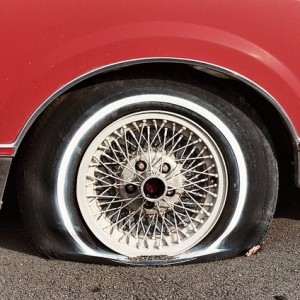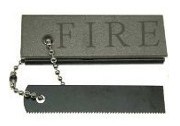|
|

Guest Post Lee Flynn
The polar vortex has got everyone talking about cold weather. But while we are exclaiming about the ridiculously low temperatures and naming things “polar vortex,” there are plenty of people who are right in the thick of some of the most extreme weather the world has seen in decades. And though there have been some fatalities as a result of the cold weather, there is a far more common occurrence of people being stranded in their vehicles for days at a time. In these sorts of situations it is difficult to survive, but if you are properly prepared, it can be done. Here are some of the most important things for you to keep in your car in case of emergencies this winter.
Food
If you are going to be stuck in your car for 12 or more hours, there is one thing for which you will be grateful above all else: food. And even if it is not winter, storing emergency food should be a top priority for any car owner. Remember to store things that can last for a long (Read more....) […]
 by Michael Green by Michael Green
Tires are the shoes of your car. They are (ideally) the only part of your vehicle that is supposed to be making contact with the road, making sure that control over the multi-horsepower machine is maintained as it travels over the road at speeds unattainable by mere land-dwelling animals.
While they are meant to be worn down, some of us motorists aren’t exactly doing it the right way. The result? The tires need to get replaced way before they were expected to. Worse, they could give out on you while you’re on the road, sometimes in the most catastrophic of ways.
The time, money, stress, and risk to life and limb just aren’t worth being careless with your automobile’s tires, so for the sake of educating my fellow car owner and driver, here are some common causes of premature tire wear and damage, and ways to avoid them:
Incorrect Tire Pressure
This is probably one of the most frequent causes of tires having uneven tire wear and inevitably, damage that can seriously affect the performance and integrity of the tire. Various tire sizes and types have (Read more....) […]
 Guest Post Mark S. Guest Post Mark S.
Why communicate at all?
And you shall know the truth, and the truth shall make you free. John 8:32
For our safety, edification, and survival we need to know what is happening and what to do about it. As the plethora of prepper blogs and forums reveal, preppers have a lot to say—much of it informative, enlightening, and insightful and some of it disinformation, illogical, unmitigated drivel, and even evil. We need to screen the nuggets from the waste. Logic, critical analysis, and a well-formed conscience help us do that.
Even now, before events have hit nadir, we avoid controlled media. At best, mass media is useless; at worst, it is destructive to mind, body, and soul. What mass media provides is not news or information, but diversions, disinformation, outright lies, smut, and hasbara. Thinking people have come to depend upon the “alternative media” of the internet, but, when times get worse, the internet “kill switch” will deprive us of that source. We will be “in the dark” unless we build alternative means and networks. Better to build now than during a crisis. Amateur radio, “ham radio,” is one way to build friendships and networks now, (Read more....) […]
 Guest Post Lee Flynn Guest Post Lee Flynn
Fulfilling our basic needs of warmth, protection and food in an apocalyptic situation or after natural disaster can be challenge, but it doesn’t have to be if you prepare properly ahead of time. Spending some time and money investing in quality food and supplies will take you a long way in desperate times. The last thing you want to do is be stuck without the basic necessities in a bad situation.
Creating Warmth
In a natural disaster, you might be facing snow, wind, rain, or freezing temperatures. Investing in a subzero proof sleeping bag for each person in your family will ensure warmth no matter how cold it gets; and protect them from frostbite and hypothermia. Fleece blankets for during the day time are also good to keep in your kit, since shelters aren’t always the warmest.
Thermal under armor, ski glasses, waterproof boots, waterproof gloves, lined coats and hats should also be in your kit for each person to keep everyone dry and warm. Thin gloves and beanies allow water to seep in and chill the body down leading to hypothermia. Keeping your health in a disaster is of up-most importance, so don’t skimp (Read more....) […]
 Guest Post – Danielle M. Guest Post – Danielle M.
Flooding, hurricanes, tornadoes, wildfires and earthquakes can strike at any time and often with little warning. In 2012, nearly 125 million people worldwide were victims of natural disasters, and in the United States, weather-related disasters caused about $157 million in damages.
The time to prepare for a disaster is not before or just after it hits – the best time to prepare is now. Making your own emergency survival kit and having a plan in place could save your life when disaster strikes. Take a look at these tips for how to make your own DIY emergency kit:
Food: For an emergency survival kit, you should have at least a three-day supply of non-perishable food items for each member of your household, including pets. Canned foods, pre-packaged and dry foods like rice and beans are the easiest to store and pack. You can easily store dry rice and beans in mason jars, empty milk jugs and empty 2-liter soda bottles. Choose foods that are high in calories and nutrition. Peanut butter, nuts, tuna, soup, crackers, protein bars and trail mix are easy to pack and offer important nutrients.
Water: For survival situations, (Read more....) […]
 Guest Post- Danielle M. Guest Post- Danielle M.
The Colorado flooding earlier this year washed away highways, interstates and even small towns. In its wake, it left behind another lesson on disaster clean up and preparedness.
The storm
Heavy rainfall hit on September 9, and didn’t let up until Sept. 13. The storm front was trapped against the Rockies, which meant four days of heavy rain. Rainfall totals equaled 14.62 inches — about two-thirds of the annual rainfall for the area.
The aftermath
Nine people died in the flooding, and many, many more lost their homes. Eighteen towns, including Denver, were hit by flash flooding. Smaller towns high in the mountains were hit particularly hard, and assistance was a long time coming thanks to roads being completely washed out. In many places, only bedrock is left where asphalt used to be — a state that could remain until 2015.
Left without options for getting down the mountain, Colorado flood survivors can (Read more....) […]
 A little preemptive planning turns car trouble from your worst nightmare to a minor inconvenience. If your vehicle blows a tire, runs out of gas or loses a battery charge, don’t panic. There are simple steps you can take to keep your car alive, on the road and away from the curb. A little preemptive planning turns car trouble from your worst nightmare to a minor inconvenience. If your vehicle blows a tire, runs out of gas or loses a battery charge, don’t panic. There are simple steps you can take to keep your car alive, on the road and away from the curb.
Roadside Assistance
If your car is new or you purchased an extended warranty or service plan, it probably included some type of roadside assistance. That typically consists of services like towing, battery and tire replacements, lockout assistance and so on. If your car is older or out of warranty, there are a few places you can still sign up for service. Most insurance companies offer it as an add-on to your coverage, but make sure you know exactly what you’re paying for since each company varies in offering.
Another option is a company like AAA. For $55 per year, they offer the same services and partner with different service centers across the country, making costs a bit lower if you need to have work done once you’re towed there. If you prefer your new wheels to come from other retailers such as Continental tires, AAA will still (Read more....) […]
|
|
















